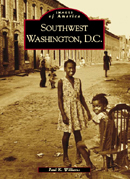Southwest Washington, D.C.

Southwest Washington, D.C. is a defined neighborhood even without a proper name, but the quadrant has a clear border southwest of the U.S. Capitol Building, nestled along the oldest waterfront in the city. Its physical delineations have defined it as a community for more than 250 years, beginning in the mid-1700s with emerging farms. By the mid-1800s, a thriving urban, residential, and commercial neighborhood was supported by the waterfront where Washingtonians bought seafood and produce right off the boats. In the 1920s and 1930s, an aging housing stock and an overcrowded city led to an increase of African-American and Jewish immigrants who became self sufficient within their own communities.
However, political pressures and radical urban planning concepts in the 1950s led to the large-scale razing of most of SW, creating a new community with what was then innovative apartment and cooperative living constructed with such unusual building materials as aluminum.
Images of America: Southwest Washington, D.C. , includes nearly 200 vintage images that document this dramatic change. Archival etchings, maps, and photographs combine to illustrate early settlers, the hanging of the Lincoln conspirators at the U.S. Penitentiary, the famous slavery escape on the schooner Pearl , a thriving African American community, and the widespread urban renewal that demolished most of its physical history and the innovative buildings that replaced it.